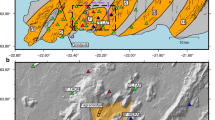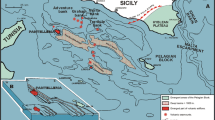Abstract
The volcano Hekla in south Iceland had its latest eruption in January–March 1991. The eruption was accompanied and followed by considerable seismic activity. This study examines the seismicity in the Hekla region (63°42′–64°18′N, 18°30′–20°12′W) during a period when the high activity related to the eruption had ceased, from July 1991 to October 1995. The aim is to define the level of the normal background seismicity of the area that can be compared to the eruption-related activity. The Hekla Volcano proper was generally aseismic during the study period. The most prominent earthquake cluster is in the neighbouring Torfajökull Volcano. The epicentres are concentrated in the western part of the caldera and west of it. The hypocentres are located at all depths from the surface down to 14 km, with highest activity at 5–12 km. Inside this cluster, in the northwest part of the caldera, is a spherical volume void of earthquakes, approximately 4 km in diameter and centred at 8 km depth. This is interpreted as a cooling magma body. Small, low-frequency events of volcanic origin were occasionally recorded at Torfajökull. This activity has mainly occurred in swarms and was most abundant during the first year of the study period, presumably reflecting some kind of connection to the 1991 Hekla eruption. Our study area also includes the easternmost section of the South Iceland seismic zone, a transform zone characterized by bookshelf faulting on transverse faults. Two lineaments of epicentres were identified, roughly corresponding to mapped faults of the South Iceland seismic zone. The hypocentres are relatively deep, mainly at 6–12 km, matching the general trend of hypocentral depth increasing toward the east. The seismicity is highest in the area of the mapped faults. However, the epicentres extend beyond them and indicate greater width of the South Iceland seismic zone, or 20–30 km rather than approximately 10 km as indicated by the length of the surface faults. The seismicity in the volcanic systems of Hekla and Vatnafjöll shows some characteristics of the South Iceland seismic zone. Epicentres are concentrated into two N–S lineaments, one of which coincides with the location of the 1987 Vatnafjöll earthquake (Mw=5.9), a strike-slip event on a N- to S-trending fault. The hypocentres of the Hekla–Vatnafjöll events are mainly at 8–13 km depth, which indicates a continuation of the depth trend of the earthquakes of the South Iceland seismic zone. The events located at Hekla proper and immediately north of it are all of low-frequency character, which can be held as an indication of volcanic origin. On the other hand, they show clear S arrivals at observing stations like normal high-frequency tectonic earthquakes.
Similar content being viewed by others
Author information
Authors and Affiliations
Additional information
Received: 12 July 1996 / Accepted: 9 June 1997
Rights and permissions
About this article
Cite this article
Soosalu, H., Einarsson, P. Seismicity around the Hekla and Torfajökull volcanoes, Iceland, during a volcanically quiet period, 1991–1995. Bull Volcanol 59, 36–48 (1997). https://doi.org/10.1007/s004450050173
Issue Date:
DOI: https://doi.org/10.1007/s004450050173




